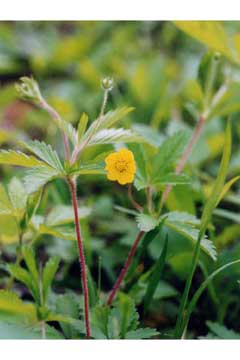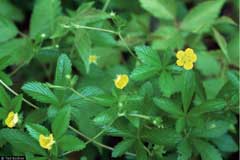 |
|
Jennifer Anderson @ USDA-NRCS PLANTS Database |
 |
| Ted Bodner @ USDA-NRCS PLANTS Database / James H. Miller and Karl V. Miller. 2005. Forest plants of the southeast and their wildlife uses. University of Georgia Press., Athens. |
Translate this page:
Summary
Physical Characteristics

 Potentilla simplex is a PERENNIAL growing to 0.1 m (0ft 4in) by 0.5 m (1ft 8in).
Potentilla simplex is a PERENNIAL growing to 0.1 m (0ft 4in) by 0.5 m (1ft 8in).
See above for USDA hardiness. It is hardy to UK zone 3. It is in flower from June to August. The species is hermaphrodite (has both male and female organs) and is pollinated by Insects. The plant is self-fertile.
Suitable for: light (sandy), medium (loamy) and heavy (clay) soils and prefers well-drained soil. Suitable pH: mildly acid, neutral and basic (mildly alkaline) soils. It can grow in semi-shade (light woodland) or no shade. It prefers moist soil.
UK Hardiness Map
US Hardiness Map
Synonyms
Plant Habitats
Woodland Garden Sunny Edge; Dappled Shade;
Edible Uses
References More on Edible Uses
Medicinal Uses
Plants For A Future can not take any responsibility for any adverse effects from the use of plants. Always seek advice from a professional before using a plant medicinally.
Antiseptic Astringent Dysentery
The plant is mildly astringent and antiseptic[207]. A decoction is used as a gargle for loose teeth and spongy gums[207, 257]. An infusion of the roots has been used in the treatment of dysentery[257].
References More on Medicinal Uses
The Bookshop: Edible Plant Books
Our Latest books on Perennial Plants For Food Forests and Permaculture Gardens in paperback or digital formats.

Edible Tropical Plants
Food Forest Plants for Hotter Conditions: 250+ Plants For Tropical Food Forests & Permaculture Gardens.
More

Edible Temperate Plants
Plants for Your Food Forest: 500 Plants for Temperate Food Forests & Permaculture Gardens.
More

More Books
PFAF have eight books available in paperback and digital formats. Browse the shop for more information.
Shop Now
Other Uses
References More on Other Uses
Cultivation details
Easily grown in a well-drained loam, preferring a position in full sun but tolerating shade[1]. Prefers an alkaline soil but tolerates a slightly acid soil[200]. Plants grown in rich soils produce more foliage at the expense of flowering[200]. Hardy to about -25°c[200]. Members of this genus are rarely if ever troubled by browsing deer[233].
References Carbon Farming Information and Carbon Sequestration Information
Temperature Converter
Type a value in the Celsius field to convert the value to Fahrenheit:
Fahrenheit:
The PFAF Bookshop
Plants For A Future have a number of books available in paperback and digital form. Book titles include Edible Plants, Edible Perennials, Edible Trees,Edible Shrubs, Woodland Gardening, and Temperate Food Forest Plants. Our new book is Food Forest Plants For Hotter Conditions (Tropical and Sub-Tropical).
Shop Now
Plant Propagation
Seed - sow early spring or autumn in a cold frame. When they are large enough to handle, prick the seedlings out into individual pots and grow them on in the greenhouse for their first winter. Plant them out into their permanent positions in late spring or early summer, after the last expected frosts. Division in spring. Larger divisions can be planted out direct into their permanent positions. We have found that it is better to pot up the smaller divisions and grow them on in light shade in a cold frame until they are well established before planting them out in late spring or early summer.
Other Names
If available other names are mentioned here
Native Range
NORTHERN AMERICA: Canada (Québec, Nova Scotia, Ontario, Prince Edward Island, New Brunswick, Newfoundland and Labrador), United States (Connecticut, Indiana, Maine, Massachusetts, Michigan, New Hampshire, New Jersey, New York, Ohio, Pennsylvania, Rhode Island, Vermont, West Virginia, Illinois, Iowa, Kansas, Minnesota, Missouri, Oklahoma, Wisconsin, Alabama, Arkansas, Delaware, Georgia, Kentucky, Louisiana, Maryland, Mississippi, North Carolina, South Carolina, Tennessee, Virginia, Texas)
Weed Potential
Right plant wrong place. We are currently updating this section.
Please note that a plant may be invasive in one area but may not in your area so it's worth checking.
Conservation Status
IUCN Red List of Threatened Plants Status :

| Related Plants
|
| Latin Name | Common Name | Habit | Height | Hardiness | Growth | Soil | Shade | Moisture | Edible | Medicinal | Other |
| Potentilla anserina | Silverweed | Perennial | 0.3 |
4-8
| F | LMH | SN | M | 3 | 3 | 2 |
| Potentilla bicolor | | Perennial | 1.0 |
5-9
| | LMH | SN | M | 1 | 0 | |
| Potentilla chinensis | Chinese Cinquefoil | Perennial | 0.6 |
-
| | LMH | SN | M | 1 | 1 | |
| Potentilla cryptotaeniae | | Perennial | 1.0 |
-
| | LMH | SN | M | 0 | 1 | |
| Potentilla discolor | | Perennial | 0.3 |
-
| | LMH | SN | M | 2 | 1 | |
| Potentilla egedei | Pacific Silverweed | Perennial | 0.5 |
4-8
| | LMH | SN | M | 2 | 1 | |
| Potentilla erecta | Tormentil, Erect cinquefoil | Perennial | 0.3 |
4-8
| | LMH | SN | M | 1 | 3 | 1 |
| Potentilla fragarioides | | Perennial | 0.3 |
-
| | LMH | SN | M | 1 | 1 | |
| Potentilla fruticosa | Shrubby Cinquefoil, Potentilla | Shrub | 1.2 |
2-6
| M | LMH | SN | M | 1 | 1 | 3 |
| Potentilla glandulosa | Gland Cinquefoil, Sticky cinquefoil, Arizona cinquefoil, Ashland cinquefoil, Ewan's cinquefoil, Hans | Perennial | 0.6 |
6-9
| | LMH | SN | M | 1 | 1 | |
| Potentilla hippiana | Woolly Cinquefoil | Perennial | 0.6 |
5-9
| | LMH | SN | M | 0 | 1 | |
| Potentilla kleiniana | | Perennial | 0.3 |
-
| | LMH | SN | M | 1 | 1 | |
| Potentilla multifida | | Perennial | 0.3 |
3-7
| | LMH | SN | M | 2 | 0 | |
| Potentilla nepalensis | Nepal Cinquefoil, Cinquefoil | Perennial | 0.6 |
5-10
| M | LMH | SN | M | 2 | 1 | |
| Potentilla norvegica | Norwegian Cinquefoil | Annual/Perennial | 0.3 |
3-7
| | LMH | SN | M | 0 | 1 | |
| Potentilla palustris | Marsh Cinquefoil | Perennial | 0.5 |
3-7
| | LMH | SN | We | 1 | 1 | 1 |
| Potentilla recta | Rough-Fruited Cinquefoil, Erect cinquefoil | Perennial | 0.6 |
4-8
| | LMH | SN | M | 2 | 1 | 0 |
| Potentilla reptans | Cinquefoil, Creeping cinquefoil | Perennial | 1.0 |
4-8
| | LMH | N | DM | 1 | 2 | 2 |
| Potentilla rupestris | Rock Cinquefoil | Perennial | 0.5 |
4-8
| | LMH | SN | DM | 1 | 0 | |
| Potentilla supina | | Annual/Perennial | 0.3 |
-
| | LMH | SN | M | 1 | 1 | |
|
Growth: S = slow M = medium F = fast. Soil: L = light (sandy) M = medium H = heavy (clay). pH: A = acid N = neutral B = basic (alkaline). Shade: F = full shade S = semi-shade N = no shade. Moisture: D = dry M = Moist We = wet Wa = water.
Now available:
Food Forest Plants for Mediterranean Conditions
350+ Perennial Plants For Mediterranean and Drier Food Forests and Permaculture Gardens.
[Paperback and eBook]
This is the third in Plants For A Future's series of plant guides for food forests tailored to
specific climate zones. Following volumes on temperate and tropical ecosystems, this book focuses
on species suited to Mediterranean conditions—regions with hot, dry summers and cool, wet winters,
often facing the added challenge of climate change.
Read More
Expert comment
Author
Michx.
Botanical References
200228235
Links / References
For a list of references used on this page please go here
Readers comment
| Add a comment |
|
If you have important information about this plant that may help other users please add a comment or link below. Only comments or links that are felt to be directly relevant to a plant will be included. If you think a comment/link or information contained on this page is inaccurate or misleading we would welcome your feedback at [email protected]. If you have questions about a plant please use the Forum on this website as we do not have the resources to answer questions ourselves.
* Please note: the comments by website users are not necessarily those held by PFAF and may give misleading or inaccurate information.
To leave a comment please Register or login here All comments need to be approved so will not appear immediately.
|
Subject : Potentilla simplex
|
|
|
|